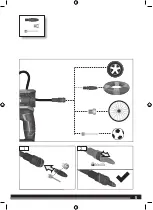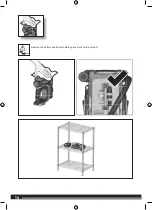
16
16
product from the original design or function.
Do not attempt to modify this product or create accessories or
attachments not recommended for use with the product. Any such
alteration or modification is misuse and could result in a hazardous
condition leading to possible serious personal injury.
Always be aware that misuse and improper handling of the product
can cause injury to yourself and others.
Household use only.
Do not use the product as a breathing device.
Never direct a jet of compressed air toward people or animals. Take
care not to blow dust and dirt towards yourself or others. Following
this rule will reduce the risk of serious injury.
Protect your lungs. Wear a face or dust mask if the operation is dusty.
Following this rule will reduce the risk of serious personal injury.
Do not use the product to spray chemicals. Your lungs can be
damaged by inhaling toxic fumes.
Risk of bursting. Carefully monitor objects during inflation to reduce
the risk of over inflation. Use a reliable pressure gauge periodically
during inflation.
To reduce the risk of over inflation, use a reliable pressure gauge
periodically during inflation. The pressure gauge on the inflator is for
reference only and is therefore not binding for exact values.
Allow the product to cool for ten (10) minutes after every ten (10)
minutes of continuous use. Never block the inflating or deflating
outlets while operating.
Remove the battery pack before starting any work on the product.
Do not dispose of used battery packs in the household refuse or
by burning them.
AEG Distributors offer to retrieve old batteries to
protect our environment.
Do not store the battery pack together with metal objects (short
circuit risk).
Use only System AEG chargers for charging System AEG battery
packs.
Do not use battery packs from other systems.
Battery acid may leak from damaged batteries under extreme
load or extreme temperatures. In case of contact with battery
acid wash it off immediately with soap and water.
In case of eye
contact rinse thoroughly for at least 10 minutes and immediately seek
medical attention.
Ambient temperature range for tool during operation is between 0°C
and 40°C.
Ambient temperature range for tool storage is between 0°C and 40°C.
The recommended ambient temperature range for the charging
system during charging is between 10°C and 38°C.
SPECIFIED CONDITIONS OF USE
The inflator may be used for the following applications.
■
Inflating high pressure items like motorbike/car/bicycle tyres and
sport equipment.
■
Inflating low pressure items like air mattresses, pool inflatables
and rafts.
Do not use the product for any other purpose.
BATTERIES
Battery packs which have not been used for some time should be
recharged before use.
Temperatures in excess of 50°C (122°F) reduce the performance of
the battery pack. Avoid extended exposure to heat or sunshine (risk
of overheating).
The contacts of chargers and battery packs must be kept clean.
For an optimum life-time, the battery packs have to be fully charged,
after used.
To obtain the longest possible battery life remove the battery pack
from the charger once it is fully charged.
For battery pack storage longer than 30 days:
• Store the battery pack where the temperature is below 27°C and
away from moisture.
• Store the battery packs in a 30% - 50% charged condition.
• Every six months of storage, charge the pack as normal.
ADDITIONAL BATTERY SAFETY WARNINGS
WARNING!
To reduce the risk of fire, personal injury, and product
damage due to a short circuit, never immerse your tool, battery pack
or charger in fluid or allow a fluid to flow inside them. Corrosive or
conductive fluids, such as seawater, certain industrial chemicals, and
bleach or bleach containing products, etc., can cause a short circuit.
Ambient temperature range for battery during use is between 0°C
and 40°C.
Ambient temperature range for battery storage is between 0°C and
27°C.
TRANSPORTING LITHIUM BATTERIES
Lithium-ion batteries are subject to the Dangerous Goods Legislation
requirements.
Transportation of those batteries has to be done in accordance with
local, national and international provisions and regulations.
■
The user can transport the batteries by road without further
requirements.
■
Commercial transport of lithium-ion batteries by third parties is
subject to Dangerous Goods regulations. Transport preparation
and transport are exclusively to be carried out by appropriately
trained persons and the process has to be accompanied by
corresponding experts.
When transporting batteries:
■
Ensure that battery contact terminals are protected and insulated
to prevent short circuit.
■
Ensure that battery pack is secured against movement within
packaging.
■
Do not transport batteries that are cracked or leak.
Check with forwarding company for further advice.
BATTERY PACK PROTECTION
The battery pack has overload protection that protects it from being
overloaded and helps to ensure long life. Under extreme stress the
battery electronics switch off the product automatically. To restart,
switch the product off and then on again. If the product does not start
up again, the battery pack may have discharged completely. In this
case it must be recharged in the battery charger.
THERMAL OVERLOAD PROTECTION
Overheated cells will reduce performance, run time and life.
Overheating can occur from battery packs being exposed to very hot
environments or from the tool they are powering being over-worked.
Summary of Contents for A18HPI
Page 1: ...A18HPI Original instructions ...
Page 4: ...4 4 5 14 6 10 8 ...
Page 5: ...5 5 1 2 ...
Page 6: ...6 6 1 2 1 2 ...
Page 7: ...7 7 78 100 33 54 55 77 10 32 10 ...
Page 8: ...8 8 BAR PSI A 1 2 3 4 4 A B 1 sec 3 sec BAR 18 8 MANUAL SETAUTO BAR PSI ...
Page 9: ...9 9 B 3 2 4 4 A B BAR 1 2 sec AUTO BAR PSI 1 2 3 sec BAR ...
Page 10: ...10 10 1 3 2 4 Manual BAR Start BAR BAR Risk of Bursting ...
Page 11: ...11 11 Auto 1 2 5 6 Stop BAR BAR BAR Risk of Bursting ...
Page 12: ...12 12 3 6 5 4 Auto Stop Start BAR BAR BAR Risk of Bursting ...
Page 13: ...13 13 BAR KP A PSI 60 sec AUTO OFF BAR BAR BAR Risk of Bursting ...
Page 14: ...14 14 Remove the battery pack before starting any work on the product ...
Page 18: ......
Page 19: ......



















